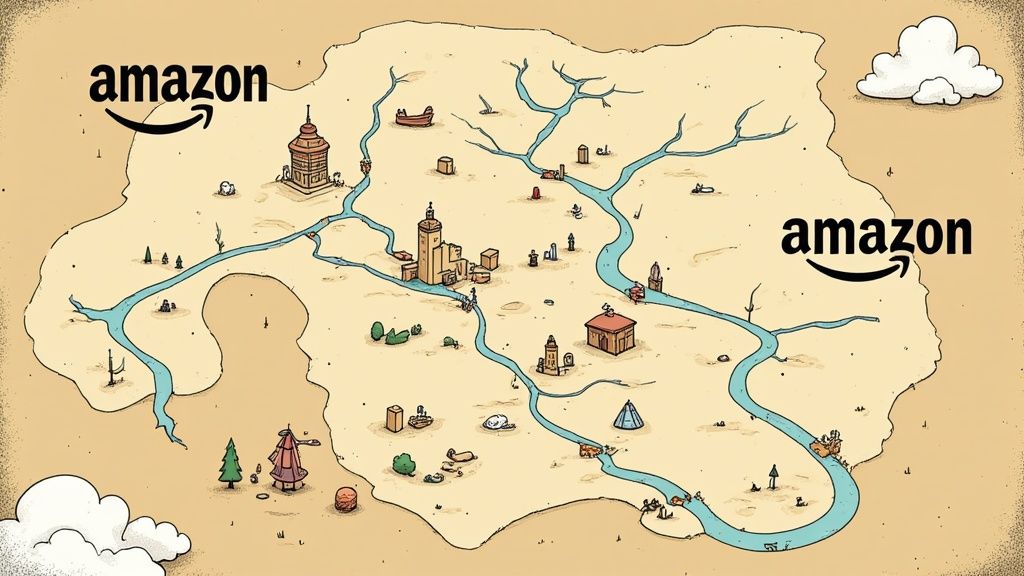Understanding Today’s Amazon FBA Success Landscape

Many entrepreneurs are drawn to Amazon FBA for its promise of independence and flexibility. But success on the platform requires more than just listing products – it demands a clear understanding of what actually drives profitable results in today’s competitive marketplace.
Decoding Amazon FBA Success: Beyond the Hype
The reality is that success doesn’t happen automatically after launching products. While independent sellers generate over 60% of Amazon’s sales, the earnings aren’t distributed evenly across sellers. Some thrive while others struggle to gain traction. The key difference often comes down to having targeted strategies rather than just maintaining a presence on the platform.
The Reality of Amazon FBA Income: Examining the Numbers
When looking at success rates, the full picture emerges in the details. While roughly 1% of sellers reach six-figure annual incomes, a larger segment (around 27%) earn between $1,000-$5,000 per year. But sales figures alone don’t tell the whole story. Storage fees, advertising costs, and other expenses directly impact actual profits. Smart sellers focus on net margins rather than just revenue targets.
The Metrics That Matter: Focusing on Key Performance Indicators
Successful sellers closely track specific metrics to optimize their businesses. Beyond basic sales numbers, they monitor conversion rates, profit margins (typically 15-40% for healthy businesses), order defect rates, and overall account health scores. These indicators help identify both problems and opportunities early on.
Adapting to the Ever-Changing Amazon Marketplace
The Amazon marketplace shifts constantly – from search algorithm updates to evolving shopper habits and new competition. Staying current requires monitoring product trends through tools like the Amazon Best Sellers Rank. Programs such as Amazon Brand Registry help protect listings and brand identity. The most successful sellers embrace change, continuously learning and adjusting their approach based on new marketplace realities rather than sticking to outdated tactics.
Mastering Product Research That Actually Works
Finding winning products on Amazon FBA takes more than just listing random items and crossing your fingers. Smart product research directly impacts whether you’ll join the top 1% of sellers or stay in the middle of the pack. The key is taking a methodical approach focused on market demand, competition analysis, and profit potential.
Identifying Profitable Niches
Instead of jumping on short-lived trends, successful sellers look for niches with steady, long-term demand. This means studying what customers consistently search for and buy while watching for gaps in current product offerings. For instance, you might spot growing interest in eco-friendly pet supplies but notice few affordable, quality options available. Finding these types of overlooked opportunities in established markets often leads to better results than chasing the latest fad.
Evaluating the Competition
Understanding who you’re up against helps shape your product strategy. Go beyond basic product ideas by analyzing existing sellers in detail – how many competitors offer similar items? What prices do they charge? What do customers say they like and dislike? This deeper competitive research reveals ways to make your product stand out, whether through better features, pricing, or positioning.
Validating Product Ideas With Data
While gut instinct plays a role, top sellers rely heavily on data to validate product choices. The Amazon Best Sellers Rank provides key insights into product demand and sales velocity within different categories. Customer reviews and competitor listings also reveal valuable details about what buyers want and value. Taking this data-driven approach reduces the risk of launching products with limited appeal.
Frameworks for Product Validation
Creating a structured process for evaluating products improves your success odds. Build a simple spreadsheet comparing potential products across key factors like demand, competition level, pricing, and estimated profits. Use keyword research tools to study search trends and buying patterns. This organized approach ensures you thoroughly assess opportunities rather than making snap decisions.
Learning From Successes and Failures
The Amazon marketplace rewards sellers who learn and adapt. Study both winning and failing product launches – yours and others – to spot what works and what doesn’t. What factors led to success? What caused products to flop? Use these insights to refine your research methods and product selection criteria over time. The sellers who consistently analyze results and adjust their approach tend to pull ahead of those who don’t.
Building a Financial Foundation for Sustainable Growth

Getting your products live on Amazon is just the beginning. To build a lasting FBA business, you need to master the financial side of operations. This means developing strategies to maintain healthy profit margins, which typically range from 15-40%. Let’s explore how successful sellers set up their finances for steady, sustainable growth.
Working Capital Management: The Engine of Your Business
Think of working capital as fuel for your FBA business – it’s the money that keeps daily operations running smoothly. You need readily available funds to buy inventory, run ads, and cover Amazon FBA fees. Without proper working capital management, you could miss major growth opportunities. For example, if a product suddenly takes off but you lack funds to restock quickly, those potential sales vanish. Smart sellers carefully forecast their cash needs and maintain enough liquid assets to act fast when opportunities arise.
Inventory Financing: Fueling Expansion
As sales increase, your inventory needs to grow too. This is where inventory financing becomes valuable – it provides targeted funding specifically for buying more products. During peak seasons or when adding new items to your catalog, this financing acts like a bridge loan. You can purchase the inventory you need now and pay it back as sales come in. The key is choosing financing options with reasonable interest rates and terms that won’t eat into your margins.
Reinvestment Strategies: The Key to Sustainable Amazon FBA Success Rate
Growing an FBA business requires strategically reinvesting profits rather than taking them all as personal income. Put a portion of earnings back into areas like product development, marketing optimization, and supply chain improvements. For instance, testing new advertising approaches can boost your Amazon visibility and sales. This creates an upward cycle where better performance funds further improvements.
Navigating Cash Flow Challenges
Even carefully planned businesses face cash flow hurdles. Shipping delays, competitive pressures, or shifting customer preferences can impact your finances. The best defense is preparation – maintain a financial buffer to handle unexpected costs. Also consider diversifying your product mix so that if one item’s sales dip, others can help maintain steady revenue. Taking these proactive steps helps protect your business during tough periods.
By getting these financial fundamentals right, you build a strong foundation for lasting success on Amazon FBA. Focus on maintaining healthy cash flow and margins while reinvesting strategically in growth. This balanced approach helps your business adapt and thrive as market conditions change.
Smart Inventory Management That Drives Profitability
Getting inventory management right directly impacts your success on Amazon FBA. Just like a chef needs to keep the perfect amount of fresh ingredients in stock, Amazon sellers must carefully balance having enough products to meet demand without tying up too much money in excess inventory. When managed effectively, your inventory approach can shift from a cost center to a major profit driver.
Demand Forecasting: Predicting the Future of Your Sales
Success starts with accurately predicting how much inventory you’ll need. This means diving into your historical sales data, understanding seasonal patterns, and keeping tabs on market changes. For instance, if you sell beach gear, your data might show sales spiking in spring as people prepare for summer. Staying alert to competitor moves and industry shifts also helps you spot demand changes early. Armed with these insights, you can adjust inventory levels to maximize sales while avoiding costly overstocking.
Reorder Timing: The Art of Timely Replenishment
Getting the timing right for reordering inventory is just as crucial as ordering the right amounts. Order too early and you’ll have cash trapped in excess stock while racking up storage fees. Wait too long and you’ll run out, disappointing customers and hurting your search rankings on Amazon. The most successful sellers combine inventory management software with carefully calculated reorder points based on supplier lead times, sales forecasts, and safety stock needs. This creates a steady flow of products that keeps sales humming.
Seasonal Planning: Preparing for Peaks and Valleys
Sales patterns can swing dramatically throughout the year on Amazon FBA. The holiday rush brings intense demand spikes, while other periods see much slower sales. Smart sellers plan months for these shifts. This often means building up inventory before peak seasons and running strategic promotions during quieter periods to maintain healthy stock levels. By thinking ahead about seasonal changes, you can capture the upside of high-demand periods while protecting yourself during slower times.
Utilizing Inventory Management Software: Optimizing Efficiency
The top Amazon sellers know that the right technology makes all the difference in inventory management. Good software handles the heavy lifting of tracking stock, creating purchase orders, and calculating when to reorder. This not only saves countless hours but also reduces costly mistakes. The best tools integrate seamlessly with other business systems to give you a complete view of inventory across all your sales channels. Having this unified view helps you make smarter decisions about stock levels based on real data rather than guesswork. When you combine solid forecasting skills with the right software tools, you gain the ability to consistently have the right products available at the right time – the key to long-term profitability on Amazon FBA.
Creating a Brand That Customers Remember

Once you’ve mastered inventory and finances, it’s time to focus on what truly sets successful Amazon FBA sellers apart – creating a memorable brand. Simply listing products isn’t enough anymore. You need to build a distinct identity that connects with customers and keeps them coming back. A strong brand does more than just attract new buyers – it creates loyal customers who make repeat purchases and recommend you to others.
Defining Your Brand Identity
Think of your brand as your business’s personality and core values. Are you focused on eco-friendly products, premium quality, affordability, or something else entirely? Your brand identity should shine through in everything from your logo and packaging to how you communicate with customers. When you’re clear about who you are and what you stand for, you’ll naturally stand out from other sellers and form deeper connections with your target audience.
The Power of Amazon Brand Registry
Building your brand is important, but protecting it is equally crucial. Amazon Brand Registry gives you essential tools to safeguard your listings and intellectual property from counterfeiters and listing hijackers. Beyond protection, it opens up valuable marketing features like A+ Content that let you tell your brand story through rich visuals and detailed descriptions. This helps boost engagement and convert more browsers into buyers.
Cultivating Customer Loyalty Through Exceptional Service
Great customer service can make or break your Amazon FBA business. Quick responses to questions, efficient problem-solving, and going above and beyond expectations build trust and set you apart from competitors. When customers have positive experiences, they’re more likely to leave good reviews, make repeat purchases, and recommend your products to others. Focus on creating consistently excellent service interactions to grow a loyal customer base.
Learning From Customer Feedback
Customer reviews provide invaluable insights for improving your brand. Pay close attention to both positive and negative feedback – they reveal what’s working well and what needs fixing in your products, packaging, or service. For example, if multiple reviews mention packaging issues, you know exactly what to improve. When you actively address concerns and show customers you value their input, you build trust and strengthen your brand reputation.
Brand Storytelling: Connecting with Your Audience
Good brand storytelling goes deeper than product descriptions – it creates an emotional connection with customers. Share what inspired your brand, explain your commitment to quality or sustainability, and show how your products make people’s lives better. For instance, if you sell eco-friendly products, tell the story of why environmental protection matters to your brand. When customers connect with your story and values, they’re more likely to choose your products and stick with your brand long-term. Remember that building a strong brand takes time and consistent effort, but the rewards of customer loyalty make it worthwhile.
Scaling Your Success: From Side Hustle to Empire

Getting started with Amazon FBA is one thing – growing it into a thriving business is another challenge entirely. While many sellers find initial success, taking your operation to the next level requires careful planning and execution. Let’s explore proven strategies that successful sellers use to scale their businesses sustainably.
Diversification: Expanding Your Product Horizons
Smart sellers know not to put all their eggs in one basket. Think of it like farming – relying on a single crop leaves you vulnerable if something goes wrong. The same applies to Amazon FBA businesses. Having just one product is risky since market trends and competition can change quickly. Instead, successful sellers carefully expand their product lines over time. For instance, if you sell kitchen gadgets, you might branch into related items like bakeware or cooking utensils. This creates multiple income streams while staying within your area of expertise.
Market Expansion: Reaching New Customers
Growth often means exploring new marketplaces beyond your home territory. While Amazon’s main marketplace offers huge potential, expanding to platforms like Amazon Canada or Amazon UK can unlock new opportunities. Some sellers also create their own e-commerce websites or partner with retail stores. This multi-channel approach helps reach more customers and protects against relying too heavily on a single platform.
Building Systems for Scalability
As your business grows, doing everything manually becomes impossible. Successful sellers invest in tools and systems that can handle increased volume efficiently. This means using software to automate inventory management, order processing, and customer service. For example, you might use Helium 10 for inventory tracking or Jungle Scout for market research. These systems save time and reduce errors, letting you focus on growth strategy instead of day-to-day operations.
Team Building and Delegation
No one can scale a business alone. As you grow, building the right team becomes crucial. This means finding people with skills in areas like marketing, sourcing, and customer support. Clear delegation helps everyone understand their role and lets you step back from daily tasks to focus on big-picture planning. It’s like conducting an orchestra – each person plays their part while you guide the overall direction.
Continuous Optimization: Refining Your Approach
Growing your business means constantly looking for ways to improve. Successful sellers regularly review their numbers, test new approaches, and adjust their strategies. This includes analyzing pricing, testing marketing campaigns, and streamlining operations. They also stay informed about Amazon’s updates and market trends. Making small improvements consistently leads to significant long-term growth.
Turning an Amazon FBA side hustle into a thriving business takes time and dedication. Focus on expanding your product line thoughtfully, reaching new markets, building efficient systems, developing a strong team, and constantly improving your approach. Looking for expert help scaling your Amazon business? Check out eStore Factory’s services designed to help sellers optimize and grow their operations.

